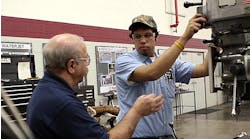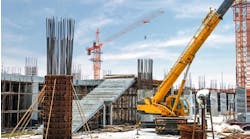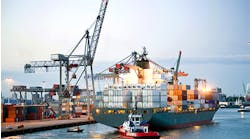Latest from Opinion
Most foundries and diecasters have been busy and happy over recent months: their order books have been full and customers have been calling regularly. The Great Recession of 2008-2009 seemed to be gone if not fully forgotten.
Look, for example, at automobile production – the industry that buys roughly 31% percent of the metalcasting industry's output. In 2010, automakers built 13.62 million cars and light trucks in the U.S., up nearly 33% from 2009's low of 9.17 million, according to the U.S. Dept. of Transportation. Caterpillar and other off-road equipment makers, John Deere and the agricultural equipment producers, all are humming! That's music to metalcasters' ears.
Now, re-wind to 2005. Domestic auto and light truck production totaled 15.9 million units that year — about 42% higher than 2009, and 14% higher than in 2010. Although automotive production has been rising, the U.S. economy still lacks momentum, unemployment is stuck at nearly 9% (or higher, depending on the source), homes are still undervalued, and consumer confidence is in the cellar.
Metalcasters' prosperity depends on OEMs. About 60% of domestically produced castings are consumed by the automotive, construction and railroad, and farm machinery industries. The remainder are sold to municipalities, specialty manufacturers, and makers of pipes and fittings. Roughly 44% of all diecastings are used in automotive powertrain applications, and the rest are purchased by OEMs in nine other industrial groups (see table.)
In their efforts to control expenses, big buyers of castings and diecastings continue to squeeze their suppliers. Originated by Detroit's automotive industry, this trend is intensifying as OEMs face slack worldwide demand and politicians everywhere dither in their efforts to revive slowing national economies.
In Europe, pols mumble "bailout" as 17 EU nations watch their currencies crumble and their national economies stumble. They are slow to approve any further trans-national fiscal solutions, so metalcasting executives … don't expect Europe to provide a quick fix to any future drop in domestic demand.
The U.S. continues to dodge its fiscal crisis. Wide concern about the federal deficit and debt obligations, high unemployment, slack demand, and dormant home prices mean low consumer confidence and flat consumer spending. There is little expectation that Washington will do anything to boost revenues and/or cut spending until after the November election — or even then. So, don't look to Washington for a quick fix.
Asia's manufacturing nations see rising labor costs adding to the problems of their export-based economies, hurt already by slack international demand. China faces an additional problem: migrant workers there have become restive, and they account for much of the labor force in the market-based special economic zones. Harsh working conditions, official corruption, repressive policies, and the central government's efforts to contain a real-estate bubble are making citizens question the legitimacy of their Communist rulers, for whom maintaining power is always a primary concern. So, don't expect sales to China's superheated economy to spur weakening demand.
In April, FedEx is reporting lower international shipments, showing that the EU slowdown is continuing and another is starting in Asia. The global steel industry is slowing, too. Prices for benchmark hot-rolled steel fell from $827 per short ton in February to below $590 in July. They rose above $600 in August, but every forecast sees further global instability for that critical commodity.
So, how should astute metalcasting execs be preparing for the next crisis? In whatever market segment they operate, metalcasters that do the best job of meeting customers' requirements will be the survivors. Astute executives today are focused on being more competitive tomorrow, when customers' requirements will be even more stringent. They are reserving cash, training executives to execute more quickly, and finding ways to motivate workers to improve their productivity.
Together, these efforts will result in the lower per-unit production costs needed to meet buyers' pricing demands and necessary to survive in flat or declining markets. They are making great efforts to define and focus on core markets, pruning their product lines, keeping only the most profitable ones with the greatest potential for growth.
Three Steps
They are taking three steps. First, an external competitive survey of customers' demands and competitors' strengths tells executives the markets with the greatest potential. They do this by analyzing market projects and sales forecasts for predictions of what will be necessary to meet future customer requirements.
Second, a rigorous survey of internal costs and productivity tell executives how to trim their costs to keep their customers. What are the costs and margins of their different product lines? With precise information on internal strengths and weaknesses, a metalcaster can plan to capitalize on its strengths and correct its weaknesses. The best way to glean this information is through an Audit of employees, supervisors, and mid-managers. Often, it requires an impartial expert with no turf to protect.
There is usually an enthusiastic response to an Audit. Frequently, employees, supervisors and managers are frustrated by executives perceived indifference and inefficient methods, so they're happy to offer a host of good suggestions for improving operations and cutting costs. Together with productivity and cost data, the Audit helps a metalcaster identify its current competitive strengths and weaknesses, and what must be done about them.
Casting executives often discover three barriers to capitalizing on internal strengths. They must:
Free executives to focus their time on long-term goals. As the problems of the organization come into focus, senior managers can be specially trained to relate their activities to their major goals, so they can concentrate on critical matters while delegating the humdrum to back-office staffers.
Develop a cadre of mid-managers who know the difference between busyness and effectiveness. That can be accomplished by training efforts to show mid-managers how to focus on their key goals, and those activities they must undertake to reach those goals.
Generate employee cooperation to meet efficiency goals. Try implementing motivation/compensation systems to generate a critical spirit that celebrates success, rewards excellence, and builds company loyalty. Executive compensation is often tied to performance. Why not compensate lower-level employees for their performance and innovation, too?
Focusing on markets with the greatest potential, shedding unprofitable products, cutting costs, and installing motivation/compensation systems to boost employee productivity and achieve company efficiency goals are all sound strategies for executives who realize that success requires being the low-cost producer among their metalcasting competitors.
However successful a foundry or diecaster may be with these strategies, it will fail unless it couples them with one final move — installing motivation/compensation systems to generate employee cooperation in achieving corporate efficiency goals.
Dr. Imberman is president of Imberman and DeForest Inc., management training in employee audits and communications, Gainsharing Plans, and other pay-for-performance programs. Contact him at 847.733.0071 or [email protected] for his reports on theswe subjects.










